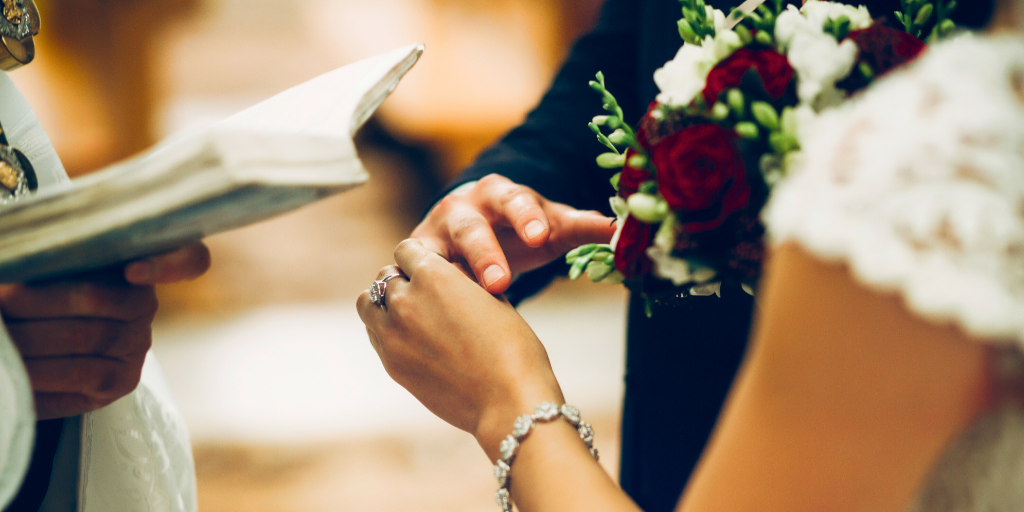
As Flávia Ghelardi's son prepares to marry, she ponders the questions each bride and groom are asked during the Catholic rite of marriage.
Flávia Ghelardi writes from Brazil in English and Portuguese. Vá para a versão em português.
My eldest son turns 22 this year and has started talking about marriage. It will be a new phase for our family, and I would like to help him understand the beauty and importance of this sacrament. There are so many things to talk about and one aspect that is often overlooked is the rite of Catholic marriage itself, which is beautiful and full of meaning.
Today I'm going to talk about the four questions that the priest asks the bride and groom in front of the altar. The bride and groom say “yes” four times, and these “yeses” correspond to the conditions for that marriage to be fully realized. These questions are asked so that the Church can be sure that the couple are committing themselves by virtue of true love.
Before you read the rest of the article, I want to offer an observation: I wrote it having in mind the Catholic Rite of Marriage that we use in Brazil. I thought it was universal and it was the same all over the world, but when I searched the internet to be sure how those questions are asked in English, I could find only three of them. What I noticed is that the questions two and three in the Brazilian rite are put together in just one (in a more direct way) in the American rite, so the meaning is the same. I translated the questions from Portuguese so my article will make more sense to you reading in English, but I added the American questions in brackets.
True love is free
The first question: “You have come here to be united in marriage. Is it of your own free will that you do so?” (Have you come here to enter into Marriage without coercion, freely and wholeheartedly?) corresponds to FREEDOM, because they are making that commitment without any kind of coercion, having freely chosen each other to walk the path of marriage. Without freedom, there is no love.

True love is total
The second question: “By entering into marriage, you are promising love and fidelity to each other. Do you promise it for life?” (Are you prepared, as you follow the path of Marriage, to love and honor each other for as long as you both shall live?) corresponds to TOTALITY, that is, the total surrender of one person to another person for life. True love requires this lifelong commitment and unreserved surrender to the person you love. Spouses give each other everything they are and everything they have so that they can truly become one flesh.
True love is faithful
The third question, “Do you promise to be faithful in joy and sorrow, in sickness and in health, loving and respecting each other all the days of your lives?” (Are you prepared, as you follow the path of Marriage, to love and honor each other for as long as you both shall live?), corresponds to the requirement of FIDELITY.
Fidelity encompasses much more than simply not going out with someone else, because betrayal itself is the pinnacle of infidelity, but there are various other forms of infidelity within marriage, which you need to be aware of and prevent.
Love remains pure when it overcomes all the selfishness that instructs the other and also when it removes all the other “loves” that distance it from the other. These other “loves” can be work, friendships, political or religious convictions, one's parents or relatives, leisure preferences, and so on. Everything that cannot be integrated, that cannot coexist with the spouse, must be repelled.
You shouldn't play with fire or “let your guard down.” A couple must always be vigilant not to let anything or anyone separate them inwardly from their spouse, as this would already be infidelity.
Fidelity also means making sure that conjugal love is a creative love, in the sense that each spouse is concerned with always improving, perfecting themselves for the good of the other. It also means trying to create an environment in the home that is pleasing to the other, trying to always become more interesting to the other, more delicate, more opportune, enriching the dialogue, overcoming the temptation of love that acts out of duty.

True love is fruitful
Finally, the fourth question: “Are you ready to receive with love the children that God entrusts to you, bringing them up in the law of Christ and of the Church?” (Are you prepared to accept children lovingly from God and to bring them up according to the law of Christ and his Church?) concerns the FECUNDITY of marriage.
All true love is fruitful, it produces fruit, because in giving oneself entirely to the other, so that the other may be happy, the one who loves sees their love bear fruit, reproduce itself, sees the growth and maturation of the other.
Spouses are called to generate new children of God, to prepare new members for the Body of Christ, to prepare new citizens for the Kingdom of Heaven, just as Christ and the Church generate new children of God. Parents give life to the body and God gives life to the soul. This mission is sublime: parents are co-creators with God of new immortal souls!

Os 4 Sim do Altar
Meu filho mais velho completa 22 anos esse ano e começou a falar em casamento. Será uma nova fase para a nossa família e eu gostaria de ajudá-lo a compreender a beleza e a importância desse sacramento. São tantas coisas para falar e um aspecto muitas vezes negligenciado é o próprio rito do matrimonio católico, que é lindíssimo e cheio de significados.
Hoje vou abordar as quatro perguntas que o sacerdote faz aos noivos diante do altar. Os noivos dizem quatro vezes "sim" e estes "sim" correspondem às condições para que aquele matrimônio seja realizado plenamente. Essas perguntas são feitas para que a Igreja tenha certeza de que o casal está se comprometendo em virtude de um amor verdadeiro.
Antes de ler o resto do artigo, gostaria de fazer uma observação: eu o escrevi tendo em mente o rito católico do matrimônio que nós usamos no Brasil. Eu pensei que era um rito universal, igual em qualquer lugar do mundo, mas quando eu procurei na internet para ter certeza como essas perguntas eram feitas em inglês, eu encontrei apenas três. O que eu percebi é que as perguntas dois e três do rito brasileiro estão unidas em apenas uma (de uma forma mais direta) no rito americano, então o significado é o mesmo. Eu traduzi as perguntas em português para que meu artigo faça mais sentido para quem estiver lendo em inglês e coloquei as perguntas que são feitas no rito americano entre parênteses.
O amor verdadeiro é livre
A primeira pergunta: "Viestes aqui para unir-vos em matrimônio. É de livre e espontânea vontade que o fazeis?" (Vocês vieram aqui para contrair matrimônio sem coerção, livremente e de todo o coração?) corresponde a LIBERDADE, pois estão assumindo aquele compromisso sem qualquer tipo de coação, tendo escolhido um ao outro, livremente, para trilhar o caminho do matrimônio. Sem liberdade, não existe amor.

O amor verdadeiro é total
A segunda pergunta: "Abraçando o matrimônio, ides prometer amor e fidelidade um ao outro. É por toda a vida que o prometeis?" (Vocês estão preparados, ao seguir o caminho do casamento, para amar e honrar um ao outro enquanto ambos viverem?) corresponde à TOTALIDADE, ou seja, a entrega total de uma pessoa a outra pessoa por toda a vida. O verdadeiro amor exige esse compromisso por toda a vida e essa entrega sem reservas à pessoa amada. Os cônjuges dão ao outro tudo o que são e o que tem para poderem se tornar verdadeiramente uma só carne.
O amor verdadeiro é fiel
A terceira pergunta: "Prometem ser fiéis, na alegria e na tristeza, na saúde e na doença. amando-se e respeitando-se por todos os dias das suas vidas?” (Vocês estão preparados, ao seguir o caminho do casamento, para amar e honrar um ao outro enquanto ambos viverem?) corresponde à exigência da FIDELIDADE.
A fidelidade abrange muito mais do que simplesmente não sair com outra pessoa, pois a traição propriamente dita é o ápice da infidelidade, mas existem várias outras formas de infidelidade dentro do casamento, as quais é preciso conhecer e se prevenir.
0 amor se mantem puro quando vence todo o egoísmo que instrumentaliza o outro e também quando afasta todos os outros "amores" que o afasta do outro. Esses outros "amores" podem ser o trabalho, as amizades, as convicções políticas ou religiosas, os próprios pais ou parentes, as preferências de lazer, etc. Tudo aquilo que não pode ser integrado, que não pode conviver com o cônjuge, deve ser repelido.
Não se deve brincar com fogo, nem "baixar a guarda". O casal sempre deve estar alerta para não deixar que nada e ninguém os separe interiormente de seu cônjuge, pois já seria uma infidelidade.
A fidelidade consiste ainda em cuidar que o amor conjugal seja um amor criador, no sentido de que cada cônjuge se preocupe em melhorar sempre, em se aperfeiçoar para o bem do outro. Significa ainda procurar criar um ambiente no lar que seja agradável ao outro, buscando tornar-se sempre mais interessante ao outro, mais delicado, mais oportuno, enriquecendo o diálogo, vencendo a tentação do amor que atua por dever.

O amor verdadeiro é fecundo
Por fim, a quarta pergunta: "Estais dispostos a receber com amor os filhos que Deus vos confiar, educando-os na lei de Cristo e da Igreia?" (Vocês estão preparados para aceitar com amor os filhos de Deus e para criá-los de acordo com a lei de Cristo e de sua Igreja?) diz respeito à FECUNDIDADE matrimonial.
Todo amor verdadeiro é fecundo, produz frutos, pois ao se doar inteiramente ao outro, para que o outro seja feliz, aquele que ama vê seu amor frutificar, se reproduzir, vê o crescimento e amadurecimento do outro.
Os cônjuges são chamados a gerar novos filhos de Deus, a preparar novos membros para o Corpo de Cristo, a preparar novos cidadãos para o Reino dos Céus, assim como Cristo e a Igreja geram novos filhos de Deus. Os pais dão vida ao corpo e Deus dá vida à alma. Essa missão é sublime: os pais são co-criadores com Deus de novas almas imortais!

Share your thoughts with the Catholic Mom community! You'll find the comment box below the author's bio and list of recommended articles.
Copyright 2024 Flávia Ghelardi
Images: Canva
About the Author

Flávia Ghelardi
Flávia Ghelardi is the mom of four, a former lawyer already "promoted" to full time mom. Flávia published her first book FORTALECENDO SUA FAMÍLIA and is a member of Schoenstatt´s Apostolic Movement. Flávia loves to speak about motherhood and the important role of women, as desired by God, for our society. She blogs at www.fortalecendosuafamilia.blogspot.com.


.png?width=1806&height=731&name=CatholicMom_hcfm_logo1_pos_871c_2728c%20(002).png)
Comments